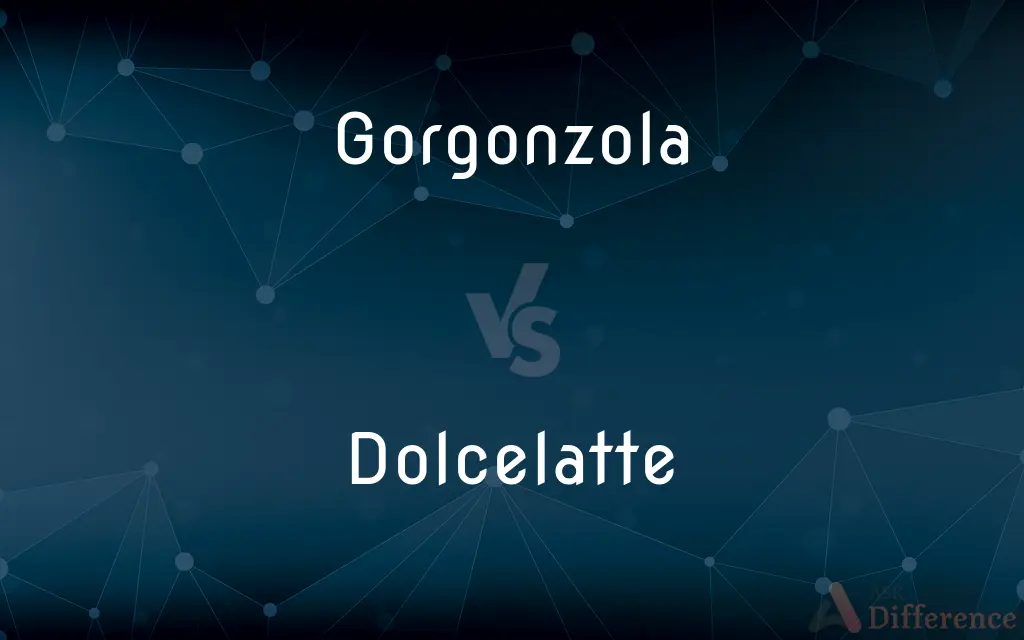Gorgonzola vs. Dolcelatte — What's the Difference?
By Maham Liaqat & Urooj Arif — Updated on March 25, 2024
Gorgonzola is a strong, aged blue cheese from Italy known for its sharp taste and crumbly texture, while Dolcelatte offers a sweeter, creamier experience, appealing to those preferring a milder blue cheese.

Difference Between Gorgonzola and Dolcelatte
Table of Contents
ADVERTISEMENT
Key Differences
Gorgonzola, originating from Italy, is a blue cheese celebrated for its robust flavor and veiny appearance, resulting from the penicillium mold. Whereas, Dolcelatte, which translates to "sweet milk," is a younger, creamier version of blue cheese, designed to be gentler on the palate.
While both cheeses are made from cow's milk, Gorgonzola is often aged longer, leading to a more pronounced flavor and firmer texture. On the other hand, Dolcelatte is aged for a shorter period, which contributes to its creamier texture and milder taste.
Gorgonzola can come in two varieties: Piccante and Dolce, with Piccante being aged longer and having a sharper taste, compared to Dolcelatte, which is always mild, sweet, and smooth, without any variation in its production process.
The process of creating Gorgonzola involves the addition of specific strains of mold, which are responsible for its distinct flavor and appearance. Dolcelatte, while also incorporating mold, is crafted to achieve a less intense mold presence, resulting in its characteristic sweetness and creamy consistency.
In terms of culinary uses, Gorgonzola is versatile, adding depth to sauces, salads, and pizzas with its strong flavor. Dolcelatte, with its milder and smoother profile, is often preferred for spreading on crackers or in dishes where a subtler cheese flavor is desired.
ADVERTISEMENT
Comparison Chart
Origin
Italy
Italy
Age
Longer aging for sharper taste
Shorter aging for milder taste
Texture
Crumbly and sometimes creamy
Creamy and soft
Taste
Sharp, robust
Sweet, mild
Varieties
Piccante (sharp), Dolce (sweet)
One variety, consistently mild and sweet
Compare with Definitions
Gorgonzola
An Italian blue cheese with a sharp, robust flavor.
Gorgonzola cheese added a bold taste to the salad.
Dolcelatte
Has a uniform texture and taste profile.
The consistent creaminess of Dolcelatte makes it ideal for spreads.
Gorgonzola
Can be aged to produce two types: Dolce and Piccante.
He preferred the sharper Piccante Gorgonzola over Dolce.
Dolcelatte
A creamy, mild Italian blue cheese.
Dolcelatte cheese was the highlight of the dessert platter.
Gorgonzola
Known for its blue veins and crumbly texture.
The Gorgonzola's crumbly texture made it perfect for the cheese board.
Dolcelatte
Often used in dishes requiring a milder cheese flavor.
Dolcelatte was the chosen cheese for the light pasta sauce.
Gorgonzola
Originates from specific regions in Italy, with a Protected Designation of Origin.
Authentic Gorgonzola cheese comes from Italy's Lombardy region.
Dolcelatte
Designed to be sweeter and softer than traditional blue cheeses.
Dolcelatte's sweet flavor made it a favorite among those who usually dislike blue cheese.
Gorgonzola
Versatile in culinary uses, from sauces to salads.
She used Gorgonzola to create a rich sauce for the pasta.
Dolcelatte
Specifically created to offer a gentler alternative to stronger blue cheeses.
For a softer cheese option, she chose Dolcelatte over other blues.
Gorgonzola
Gorgonzola (; Italian pronunciation: [ɡorɡonˈdzɔːla]) is a veined blue cheese, originally from Italy, made from unskimmed cow's milk. It can be buttery or firm, crumbly and quite salty, with a "bite" from its blue veining.
Dolcelatte
Dolcelatte (UK: , Italian: [ˌdoltʃeˈlatte]; literally 'sweet milk') is a blue veined Italian soft cheese. The cheese is made from cow's milk and has a sweet taste.
Gorgonzola
A pungent, blue-veined Italian cheese with a soft, crumbly texture, made of cow's milk.
Dolcelatte
A mild, slightly sweet form of gorgonzola cheese.
Gorgonzola
A blue-veined Italian cheese, made from cow's milk.
Gorgonzola
A kind of Italian pressed milk cheese; - so called from a village near Milan.
Gorgonzola
Italian blue cheese
Common Curiosities
Can both cheeses be used in cooking?
Yes, both Gorgonzola and Dolcelatte can be used in cooking, offering different flavor profiles to dishes.
What is the main difference between Gorgonzola and Dolcelatte?
Gorgonzola is known for its sharp flavor and crumbly texture, while Dolcelatte is creamier and milder.
Is Gorgonzola suitable for people who are new to blue cheeses?
Gorgonzola Dolce might be suitable for beginners due to its milder flavor compared to Gorgonzola Piccante.
Can Dolcelatte be used as a substitute for Gorgonzola in recipes?
Yes, Dolcelatte can substitute Gorgonzola for a milder taste in recipes.
How should Gorgonzola and Dolcelatte be stored?
Both cheeses should be wrapped in foil or wax paper and stored in the refrigerator to maintain freshness.
Can Gorgonzola and Dolcelatte be eaten by pregnant women?
Pregnant women are often advised to avoid unpasteurized cheeses, including some varieties of blue cheese, so it's best to consult a healthcare provider.
Do Gorgonzola and Dolcelatte have any health benefits?
Both cheeses are sources of protein, calcium, and vitamins, but should be consumed in moderation due to their fat and salt content.
What type of wine pairs well with Gorgonzola?
Bold red wines or sweet dessert wines pair well with the sharpness of Gorgonzola.
What is the best way to serve Dolcelatte in a cheese platter?
Serve Dolcelatte with fruits like figs and pears to complement its creaminess and sweetness.
What dishes are enhanced by the addition of Dolcelatte?
Dolcelatte is excellent in creamy sauces, risottos, and as a topping on pizzas for a mild blue cheese flavor.
How long does Gorgonzola cheese last once opened?
Once opened, Gorgonzola should be consumed within a few weeks, stored properly in the refrigerator.
Are Gorgonzola and Dolcelatte made from cow's milk?
Yes, both cheeses are made from cow's milk.
What makes Dolcelatte sweeter than Gorgonzola?
Dolcelatte's shorter aging process and specific production methods make it sweeter and milder.
Is Dolcelatte more expensive than Gorgonzola?
Prices can vary, but Dolcelatte may sometimes be priced higher due to its specialty status.
Can Gorgonzola be considered a blue cheese?
Yes, Gorgonzola is classified as a blue cheese due to the presence of blue veins from penicillium mold.
Share Your Discovery

Previous Comparison
Receed vs. Preceed
Next Comparison
Broth vs. SoupAuthor Spotlight
Written by
Maham LiaqatCo-written by
Urooj ArifUrooj is a skilled content writer at Ask Difference, known for her exceptional ability to simplify complex topics into engaging and informative content. With a passion for research and a flair for clear, concise writing, she consistently delivers articles that resonate with our diverse audience.















































